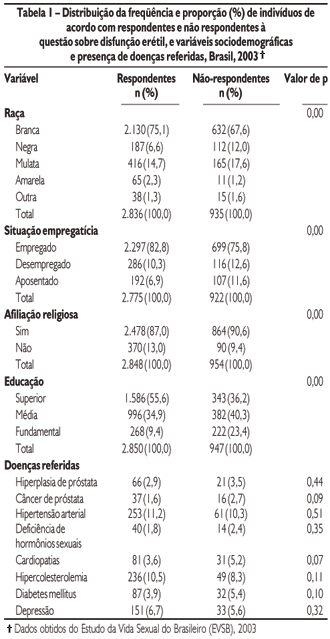OBJETIVE: To estimate the prevalence of ED and related risk factors in a sample of the Brazilian male population. METHODS: Cross-sectional study was carried out with a convenience sample of 2,862 men, 18 years of age or older, using an anonymous self-administered questionnaire. ED prevalence in the sample was obtained by a general question which was directly derived from the ED definition. Data were submitted to chi-square or Student's t tests. Logistic regression analyses were used for risk factor calculations. RESULTS: The prevalence of ED was 45.1% (31.2% mild, 12.2% moderate and 1.7% complete). Subjects with ED presented lower self-esteem, hindered interpersonal relationships, fewer sexual intercourses per week, more extra-marital relationships, complaints of lack of libido and premature ejaculation. When compared with men aged 18-39 years, men aged 60-69 presented 2.2 higher risk of ED (95% CI; 1.4-3.4; p < 0.01), whereas men aged 70 or older presented 3.0 higher risk of ED (95% CI; 1.4-6.3; p < 0.01). Level of education was inversely proportional to risk of ED. Yellow race, unemployment, religious affiliation, prostate tumor, hypertension and depression were variables that increased ED risk. CONCLUSION: The prevalence of ED was high and comparable to that found in other studies. Subjects with ED suffer from less sexual activity and poorer quality of life. Age and lower socioeconomic level are directly proportional to ED risk. Therapeutic and preventive measures should be implemented to minimize the negative impact of this condition, especially in developing countries.
Erectile dysfunction; Epidemiology; Sexual behavior; Quality of life; Etiology; Prevention and control





